Genre: Action Developer: Namco Publisher: Namco Players: 1 Released: 1993
Namco took a shine to the Genesis early, releasing a few titles until Nintendo’s fascist licensing terms forced it back to the NES. Once the veil was lifted though, the company came back in force with a ton of great games. Along with some original properties, Namco also graced Sega’s console with exclusive sequels to some franchises begun in the arcades (and even ported to other machines). Making the jump to Segaland along with the Splatterhouse series was one of the earliest examples in the side-scrolling action genre, Rolling Thunder, which went full-on exclusive with the third installment.
Not being an arcade port like its two siblings gives Rolling Thunder 3 the advantage of not having to live up to the standard expectations involved with the typical console downgrade. Aside from matching the second game visually, this third chapter doesn’t have to worry about any of the problems inherent with an arcade conversion. Namco took great advantage of this and used the Genesis hardware to give its new action title enough power to compete with the console’s heavily crowded action arena, a strategy already implemented with Rolling Thunder 2’s additional stages and cut scenes.
Part three keeps the cut scenes – they’re still a welcome feature – and this time around they’ve much more animated than before. While the narrative in the Rolling Thunder series has never been complex, there have been a few changes this time around that need development. For example, franchise stars Albatross and Leila are not playable, as the duo are off tackling Gimdo, leader of the Geldra criminal organization. In their stead, the agency has sent new operative Jay to take on Gimdo’s second-in-command, Dread. Intelligence hopes that the one-two punch combination will finally end the Geldra threat for good. So with orders in hand, Jay takes off for California to find Dread.
Along with the change in heroes comes a major upgrade to the gameplay. Unlike his colleagues, Jay has a lot of secret agent moves that give him the edge over Geldra. He can use a knife up close (great for saving on bullets in close-quarter situations), and he can shoot diagonally. I’m glad that Namco finally figured this last one out. And it only took it three games!
Jay’s biggest asset is that he’s not a one or two-hit wonder like Albatross and Leila. No, Jay can withstand up to three blows before dying, which makes the brutal difficulty the series is famous for just a tad more bearable. Moreover, players now respawn where they died, rather than being sent way back to a checkpoint. Some might consider this something of a watering down, but I think it’s about time some advancements were made with the life system.
To combat Dread across Rolling Thunder 3’s ten levels of action, Jay has a total of nine weapons, more than double than that of part two, and he can now sling grenades at his Geldra foes. Best of all, he can finally… FINALLY fire his pistol while jumping, another gameplay innovation that only took Namco three games to implement. Weapons are chosen at the start of each level (they can’t be chosen again once picked) and reloaded by going in special doors, just as in previous outings. If no weapons were chosen, entering the doors will net players an extra life bar. Jumping between floors and ducking behind boxes are still great ways to dodge enemy fire, but Jay can also hide in doorways until he’s clear to shoot back. While none of these additions may seem like major innovations, they’re really a major step forward for this series.
Namco has mixed things up even more with the stages. Where part two introduced boss battles (also included here), this chapter sees Jay take on Geldra on both a motorcycle and jet ski. Very much reminiscent of those stages of the same type from Shinobi III, they are a welcome change from the standard formula and are fun to play. Even cooler is the inclusion of three secret stages that can only be accessed by doing specific tasks, such as shooting right after the screen scrolls down in level two.
Along with the gameplay, the difficulty problems that have plagued this series have also been dealt with. While Rolling Thunder 3 is still hard as nails, it’s a tad more forgiving than its predecessors. In addition to the expanded life bar, the time limit is gone, and there are also passwords to change the difficulty level and the amount of starting lives. The game even goes so far to include the latter in the manual (entering the term “ANNOY” starts players with five lives instead of three).
If I had to air any grievances about this third installment (in addition, that is, to the main character’s total lack of appeal), it would have to be with the lack of a two-player option. Rolling Thunder 3 is an entirely single-player affair. That’s a darn shame, but it’s not a total loss. I don’t know how much a second player is actually needed here, and truth be told, I never found myself playing through the game and thinking that it would be better if someone else were playing it along with me. I guess it’s a matter of not liking things being removed, but given how much was added in exchange, I suppose it all balances out. It’s not a total loss, though, since players can at least remedy the Jay problem by using a code to swap him out for Ellen, the female agent who serves as his radio contact throughout the adventure.
Anyone who is a fan of the Rolling Thunder titles, or this type of game in general, is going to enjoy the third arc in the story. I’m loathed to label it a conclusion, as we’ve already seen how Namco has brought back Splatterhouse. I hope this series gets the same love eventually, since it’s a classic franchise that has stood the test of time. Still, we should all grab this one and play it as though it may be the last we’ll ever see. If that should indeed be the case, then it’s safe to say that the series definitely went out on a high note.
SCORE: 8 out of 10

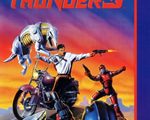
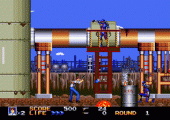
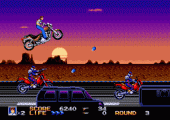
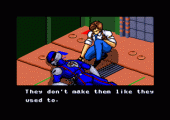
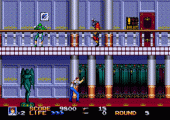
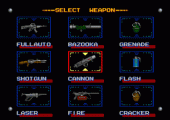
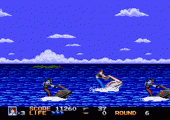
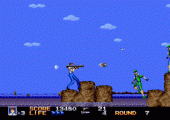
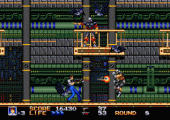
Yet another great Genesis action game!! Don’t miss out on this one!!